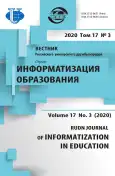Programming as a tool for across-subjects learning in primary school
- Authors: Sjöberg C.1, Risberg T.2, Nouri J.3, Norén E.3, Zhang L.3
-
Affiliations:
- Strandskolan
- Tyresö school
- Stockholm University
- Issue: Vol 17, No 3 (2020)
- Pages: 179-189
- Section: COMPUTER SCIENCE TEACHING
- URL: https://journal-vniispk.ru/2312-8631/article/view/321246
- DOI: https://doi.org/10.22363/2312-8631-2020-17-3-179-189
- ID: 321246
Cite item
Full Text
Abstract
About the authors
Christer Sjöberg
Strandskolan
Email: larare.christer@gmail.com
teacher 14 Lagergrens väg, Tyresö, 135 63, Kingdom of Sweden
Tove Risberg
Tyresö school
Email: tove.risberg@utb.tyreso.se
teacher 6 Tyresövägen, Tyresö, 135 61, Kingdom of Sweden
Jalal Nouri
Stockholm University
Email: jalal@dsv.su.se
PhD in Computer Science, Associate Professor of the Department of Computer and Systems Sciences Frescativägen, Stockholm, 114 19, Kingdom of Sweden
Eva Norén
Stockholm University
Email: eva.noren@mnd.su.se
PhD in Mathematics Education, Associate Professor of the Department of Mathematics and Science Education Frescativägen, Stockholm, 114 19, Kingdom of Sweden
Lechen Zhang
Stockholm University
Email: chen@dsv.su.se
PhD student of the Department of Computer and Systems Sciences Frescativägen, Stockholm, 114 19, Kingdom of Sweden
References
- Papert S. Mindstorms. New York: Basic Books; 1980.
- Wing, JM. Viewpoint. Computational thinking. Communications of the ACM. 2006; 49(3):33-35.
- Heintz F, Mannila L, Färnqvist T. A review of models for introducing computational thinking, computer science and computing in K-12 education. Frontiers in Education Conference (pp. 1-9). Pennsylvania, US, IEEE; 2016, October.
- Heintz F, Mannila L, Nordén LÅ, Parnes P, Regnell B. Introducing programming and digital competence in Swedish K-9 education. International Conference on Informatics in Schools: Situation, Evolution, and Perspectives (pp. 117-128). Springer, Cham; 2017, November.
- National Agency of Education. Course syllabus in mathematics, compulsory school. Stockholm: Skolverket; 2017.
- Skolvärlden. 2017. Available from: http://skolvarlden.se/artiklar/8-av-10-larare-osakra-pa-att-lara-ut-programmering (accessed: 16.01.2019).
- Sentance S, Csizmadia A. Computing in the curriculum: challenges and strategies from a teacher’s perspective. Education and Information Technologies. 2017;22(2):469-495.
- Benton L, Hoyles C, Kalas I, Noss R. Bridging Primary Programming and Mathematics: Some Findings of Design Research in England. Digital Experiences in Mathematics Education. 2017:1-24.
- Benton L, Saunders P, Kalas I, Hoyles C, Noss R. Designing for learning mathematics through programming: a case study of pupils engaging with place value. International journal of Child-Computer Interaction. 2018;16:68-76.
- Sáez-López JM, Román-González M, Vázquez-Cano E. Visual programming languages integrated across the curriculum in elementary school: a two year case study using “Scratch” in five schools. Computers & Education. 2016;97:129-141.
- Yoshida M. Mathematics lesson study in the United States: current status and ideas for conducting high quality and effective lesson study. International Journal for Lesson and Learning Studies. 2012;1(2):140-152.
- Ermeling A, Ermeling G. Learning to learn from teaching: a first-hand account of lesson study in Japan. International Journal for Lesson and Learning Studies. 2014;3(2):170-191.
- Programmering i ämnesundervisning [Programming in subject didactic]. Available from: https://www.ifous.se/programmering-i-amnesundervisningen/ (accessed: 10.04.2020).
- Nouri J, Norén E, Skog K. Didactical strategies employed by teachers when teaching programming in K-9 education. The 12th Annual International Technology, Education and Development Conference (Valencia, Spain, March 5-7, 2018) (pp. 7983-7989). The International Academy of Technology, Education and Development; 2018.
- Sjöberg C, Nouri J, Sjöberg R, Norén E, Zhang L. Teaching and learning mathematics in primary school trough “Scratch”. International Conference on Education and New Learning Technologies, EDULEARN18 Proceedings (pp. 5625-5632). 2018.
Supplementary files









